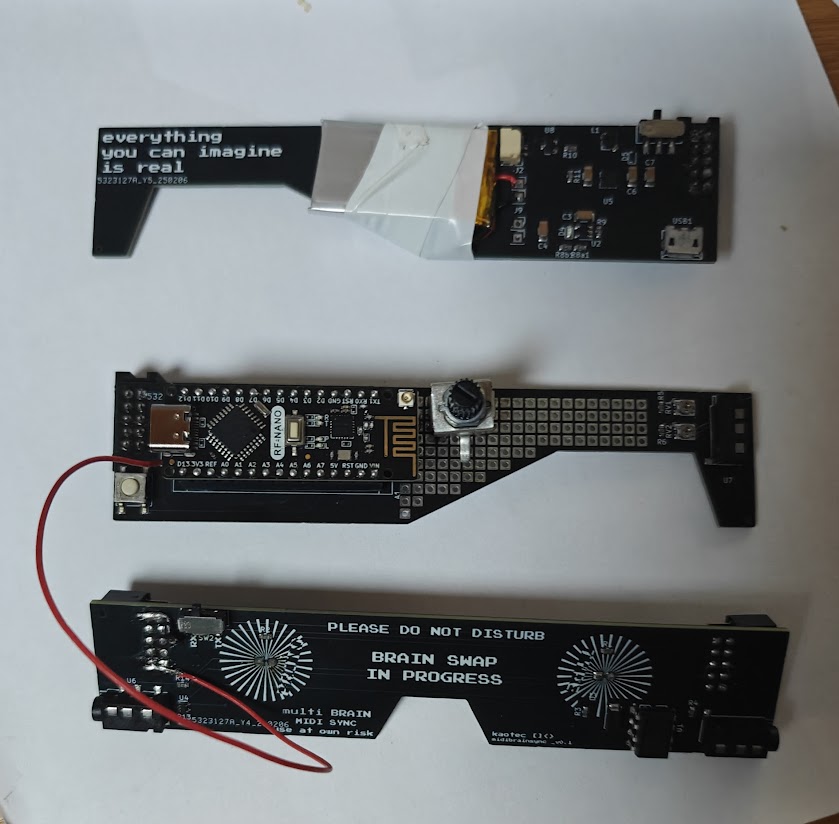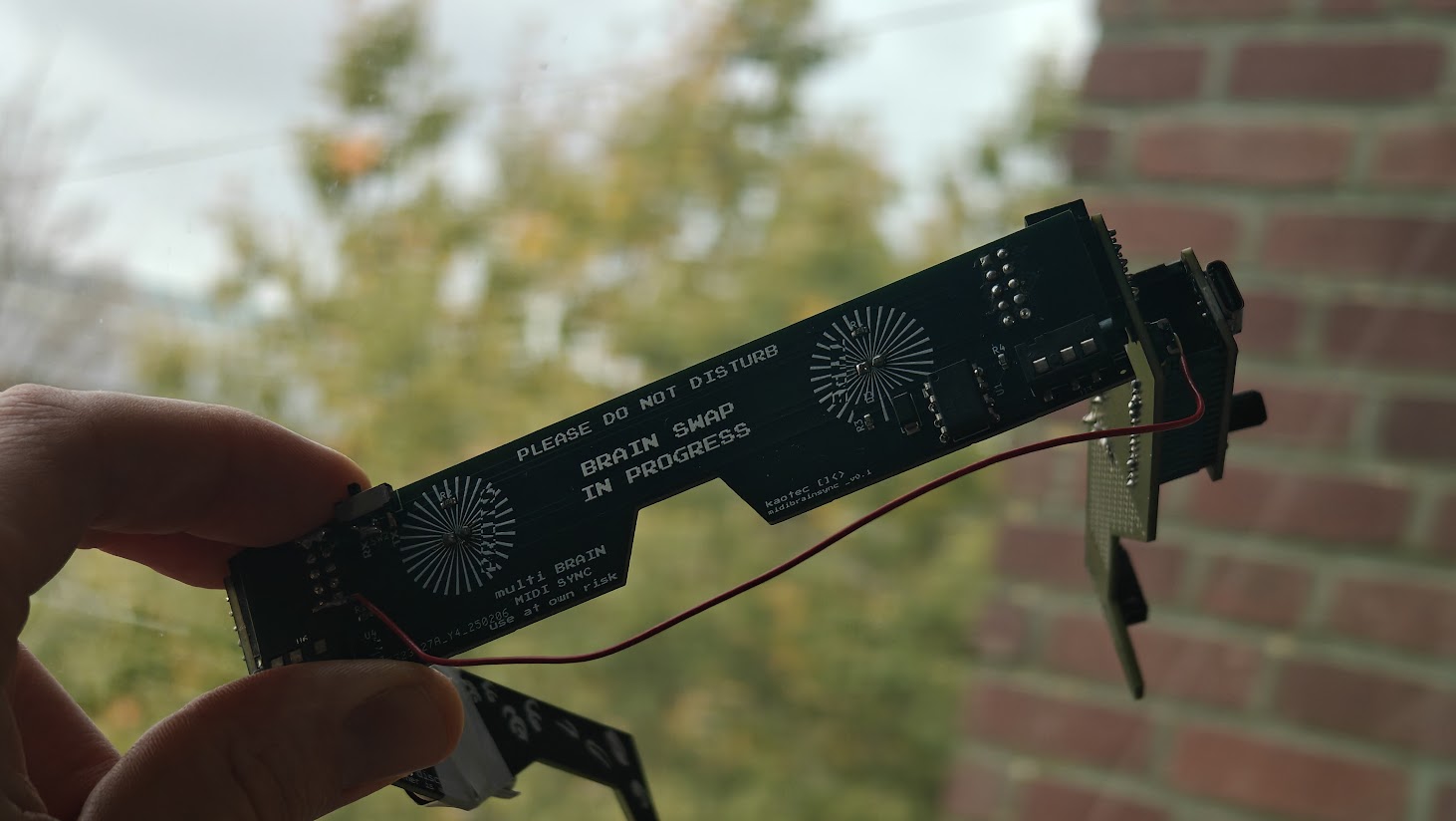brainsyncglasses
First prototype of the brainsync glasses is out there
After some experimenting, I put the prototype out there, I guess I need a manual now. This first version has wireless sync capabilities. Still looking for an update to it to enable the midi sync, but it will need a rework. I also lost the original KiCad files in a git purge disaster. Still they work!
assembly
The glasses are made from 3 parts: - Battery side - controller side - LED front

The battery side has a microusb connector to charge the device. Do not charge while using. It also has the on/off switch. Turn it off before conecting the boards
Just connect the 10-pin connectors, making sure the board aligns well. You now have glasses
The front side has 2 TRS connectors. They are for connecting MIDI devices. This is broken in the first prototype. The switch, selecting between sending and receiving midi, is also broken.
The front side is connected to the controller side using a red cable. This is due to routing bug in the board. It needs to be coinnected to a ground pin on the controller board. and to the ground pins of the 10 pin connector on the battery side of the view front.
The controller board has a button, a arduino controller with USB-C connector and RF module a potentiometer an headphone jack and two trim pots near the headphone jack for volume control

brainwave modes:
quoted = (copy paste from internet)
LEDS
Just LEDs flashing to the brain frequency wanted, cuases brain modulation
audio
/*********
VARIABLES for tone generator The difference in Hz between two close tones can cause a 'beat'. The brain recognizes a pulse between the right ear and the left ear due to the difference between the two tones. Instead of assuming that one ear will always have a specific tone, we assume a central tone and create tones on the fly half the beat up and down from the central tone. If we set a central tone of 200, we can expect the following tones to be generated:
Hz: R Ear L Ear Beat
Beta: 192.80 207.20 14.4
Alpha: 194.45 205.55 11.1
Theta: 197.00 203.00 6.0
Delta: 198.90 201.10 2.2
You can use any central tone you like. I think a lower tone between 100 and 220 is easier on the ears than higher tones for a meditation or relaxation. Others prefer something around 440 (A above Middle C). Isolating the central tone makes it easy for the user to choose a preferred frequency base.
*********/
menu controls
- button
- potentiometer
menu mode
turn on the device, with the button held down to enable leader mode. Other devices in the range of the leader will follow the same frequency as the leader.
menu structure
When turning on the device, you enter the menu. Turning the potentiometer selects the devices mode. After pressing the button, you enter the mode. After pressing it again you go back to the menu. The modes are represented in the menu by blinks of the LEDs, either short pulses or long pulses
modes
you read the mode by reading how the LEDS turn off in a cycle
X = LED off pulse, - = on pause
mode 1 - GOOD_MORNING
X-----------
one short pulse, one very long pause
Use this mode to refresh and start the day
mode 2 - GOOD NIGHT
X--X--------
two short pulses, one long pause
relax, wind down, before going to bed
mode 3 - VISUALS
X--X--X-----
three short pulses, long pause
Here for the lights, gimme more
mode 4 - MEDITATION
XXX---------
one long pulse, very long pause
Tries to guide you into medition state
long pulse, long pause
mode 5 - MEDITATION CHUNKY
XXX--XXX----
long pulse, short pause, long pulse, long pause
Same but with chunky transitions
Altman's "chunky" frequency-hopping method
BRAINWAVE TABLE Table of values for meditation start with lots of Beta (awake / conscious) add Alpha (dreamy / trancy to connect with subconscious Theta that'll be coming up) reduce Beta (less conscious) start adding Theta (more subconscious) pulse in some Delta (creativity) and then reverse the above to come up refreshed
mode 6 - SETUP
X-X-X-X-X-X-
fast blink, repetitive
Set the LED brightness using the potentiometer
mode 7 - SYNC
--X-X-X-X-X-
Fast blink, one longer pause
Sync to other glasses over the wireless
midi mode
currently broken on hardware level :-/
all this would not have been possible without
schematics/code used
the arduino code for the frequency hopping (unchanged) https://github.com/thedod/Arduino-Brain-Machine
the battery charger reference implementation
https://github.com/trentfowler/lithium-charger-with-5v-booster
I messed up my git repo where I was keeping my code for this project, doing a purge for big files, I accidentially erased schematics and backups... I need to do a lot of digging to find that back
